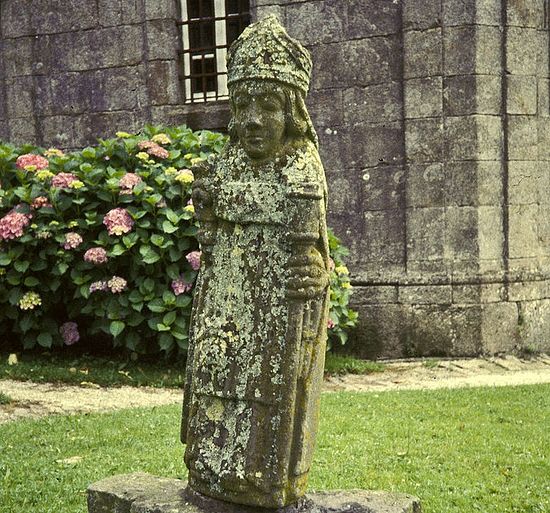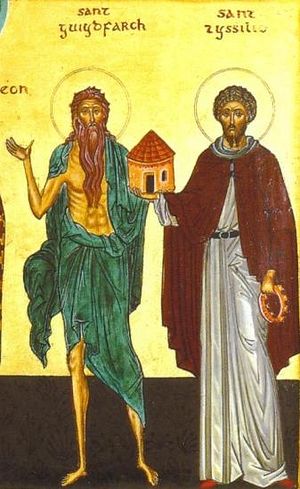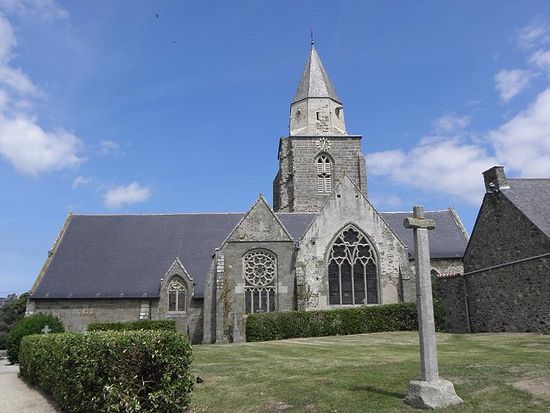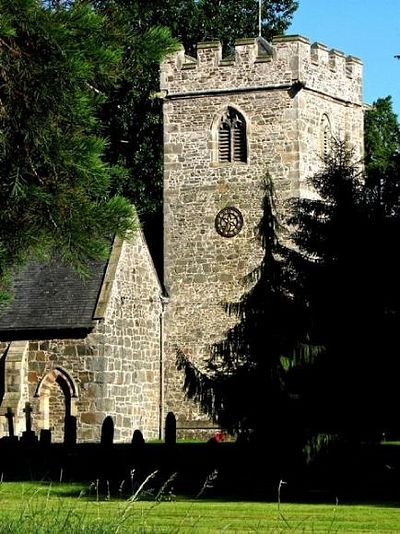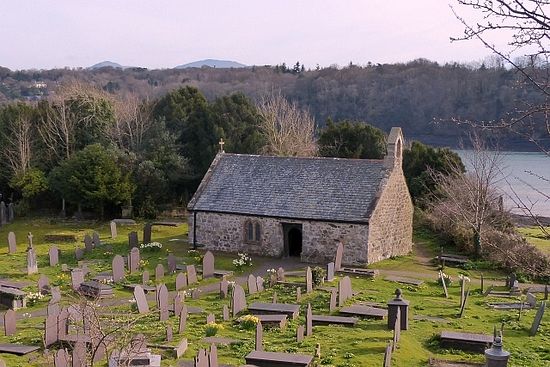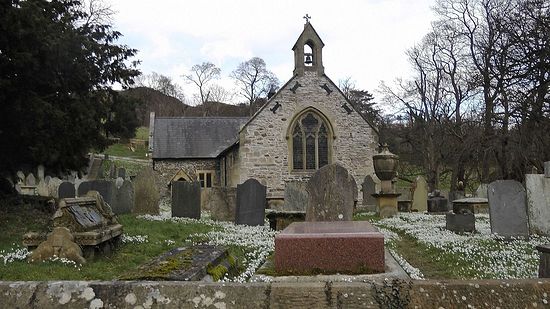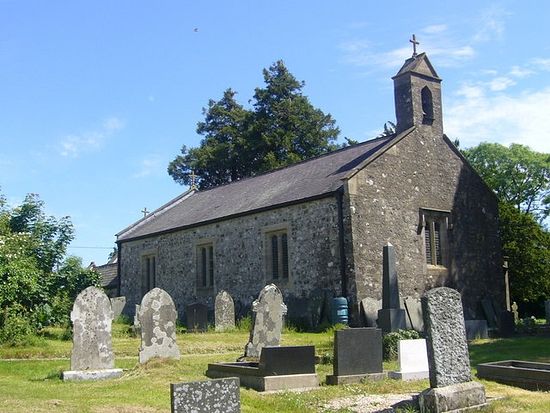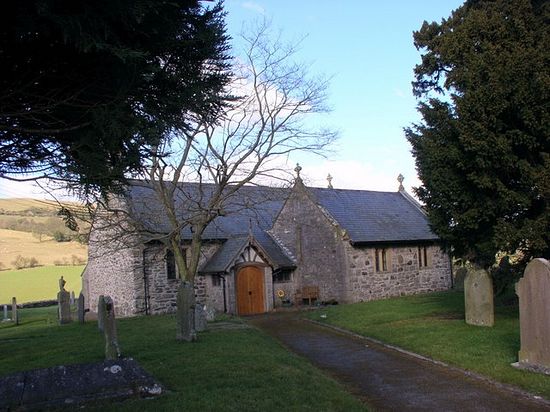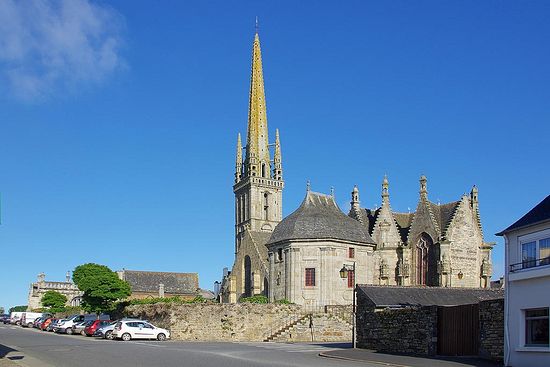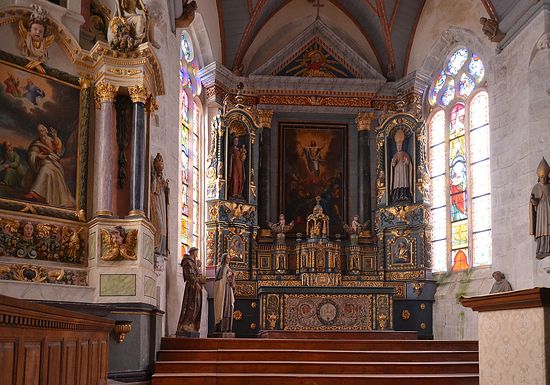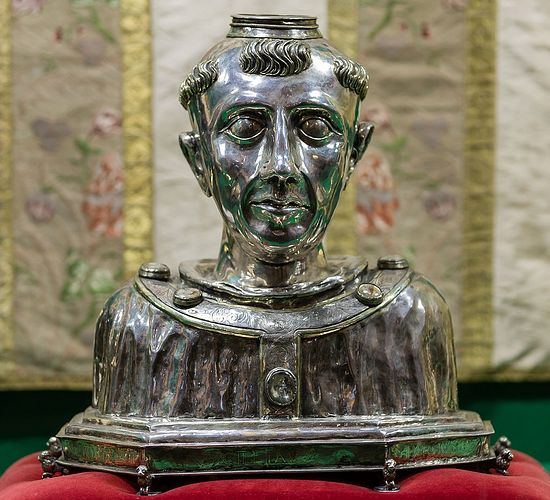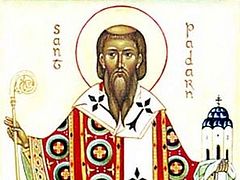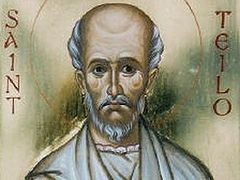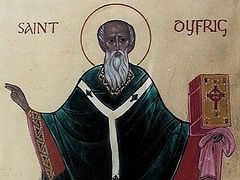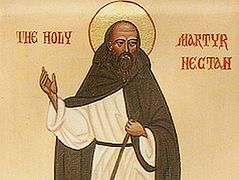St. Tysilio (also spelled Tyssilo, Tyssel, Suliau, Suliac), whose name means “Dear Little Sunday’s Child”, is ranked among the Fathers of the Welsh Church. He lived in the second half of the sixth and first half of the seventh centuries. Meifod in the Welsh county of Powys has been the main center of his veneration over the centuries. The saint’s father was Brochwel, a king of the early Welsh kingdom of Powys, which corresponds to part of today’s central eastern Wales and the western English county of Shropshire.
Tysilio, the youngest and the most talented of his siblings, was drawn to a serious, ascetic Christian life from his childhood. Thus, despising all earthly riches and refusing his inheritance, as a very young man Prince Tysilio left his home and went to study at the monastery of Meifod in the same kingdom (now the county of) Powys. This monastery had been founded by the holy hermit and abbot Gwydfarch (also spelled Gwyddfarch, locally commemorated on November 3) in about 550 and he then ruled it. Gwydfarch was a famous mentor and due to him (and later to St. Tysilio), Meifod grew into a celebrated center of Welsh monasticism and learning. Tysilio’s father first wanted his son to come back home and lead his army, but, having convinced in the sincerity of the young prince’s determination to devote his life to the service of God in the strictness of monastic life, he reconciled himself to this state of affairs. At Meifod Monastery Tysilio was trained in monastic life and discipline, became a disciple of St. Gwynfarch and also met there young St. Beuno, with whom he made friends. According to some sources he may also have been at the famous Bangor Monastery in Gwynedd.
With time, seeking a stricter solitary life and contemplative prayer, the holy man Tysilio with the blessing of the fathers left the monastery and retreated to a small isle near the much larger island of Anglesey off the north-western Wales in the Menai Straits (a small channel separating Anglesey from the mainland of NW Wales, it has been spanned by two bridges since the nineteenth century). Today this isle is connected with Anglesey by a causeway. Tysilio lived on the isle for seven years as an anchorite and by his righteous life and gift of prayer he gained the love of everyone. This isle was later called Ynys Dysilio (“St. Tysilio’s Island”) in Welsh, or Church Island in English, after St. Tysilio—the name it retains to this day. The man of God preached much in the surroundings, especially on neighboring Anglesey, for which he was esteemed as an enlightener. After this missionary work Tysilio went back to Meifod and became its abbot after Gwydfarch. The holy abbot rebuilt the monastery’s church and built another church nearby.
As was the case with the majority of Celtic saints, Tysilio did not remain at the same monastery forever—he made frequent missionary journeys and later returned to the eremitical life. Though we have scant information of his life at that period, what we do know is that Tysilio became famous as an active builder of churches: the churches built by him existed in the historic regions of Clwyd (NE Wales), Cardiganshire, Dyfed (SW Wales) and in the area along the Menai Straits (NW Wales). Tysilio made numerous visits to the holy monasteries and shrines of the country of that time. According to tradition, the ascetic for some time lived in solitude in a small hermitage which he built for himself in the place that afterwards became known as “Llantysilio” (meaning “church” or “enclosure of Tysilio”). Some historians claim that Tysilio may have served as Bishop of St. Asaph, but there is no evidence to support this.
When St. Tysilio’s brother died, his widow—the saint’s sister-in-law—wished to marry him (despite his vow of celibacy!) and make him the King of Powys. Of course, the saint of God turned down both proposals and continued to rule his principal monastery of Meifod. His monastery, like other early Welsh monasteries, was a “clas” (the plural in Welsh is “clasau”)—a monastic settlement with self-administration governed by an abbot. Clasau were also mother-churches of other, smaller communities. Tysilio was a wise abbot, renowned faster and man of prayer. Among his close friends (in another tradition—cousins) were such illustrious saints as Deiniol and Asaph. However, for some political reasons soon Meifod Monastery was persecuted by the royal family. Thus, Tysilio, following the example of a great many Welsh and Cornish ascetics, resolved to leave his motherland forever and go and take the light of Christ to Brittany (originally called Armorica) in the north-west of present-day France.
Taking a small group of disciples with him, in about the year 617 Tysilio embarked for Brittany. In the Breton land the man of God founded the monastery of St. Suliac, becoming its first abbot. The saint undertook a missionary work in the region and reposed at his beloved monastery of St. Suliac in about the year 640 at a very advanced age. Tysilio was buried at his monastery, whose main church was most probably dedicated to St. Laurence. Unfortunately, nothing survives of the Breton monastery. However, the present-day village of St. Suliac (the Ille-et-Vilaine department, Brittany) is named after him and considered to be one of the prettiest villages in France, Some of its houses incorporate the fabric of the old monastery. The village is dominated by the splendid thirteenth-century church of “St. Suliac” which stands on a hill and is richly decorated. There is an opinion among the historians that the St. Tysilio who lived in Wales and the one who founded St. Suliac Monastery are two different saints, but there are insufficient grounds to support this idea.
St. Tysilio enjoyed fame as a scholar and writer. Some researchers attribute “The Brut Tysilio” Welsh chronicle of kings to this saint. Tysilio is venerated in North Wales to this day. A number of churches are dedicated to him there and several place names are derived from his name.
Today Meifod is a small village in the county of Powys close to the town of Welshpool. It is famous as the burial place of members of the ancient royal family of the kingdom of Powys. It is also noted for its large parish church (the Church in Wales) dedicated to St. Tysilio and the Mother of God. Most of the current church is of the sixteenth-century, though it retains several Norman features, such as the arches at the entry to the vestry and the tower arch. In the Victorian era the temple was substantially restored and partly enlarged. Inside visitors can sense a good mix of various architectural styles. Significantly, this place of worship has been active for 1,500 years and has been Orthodox, Roman Catholic and now Anglican. Unusually, the church has a cross slab dating to the ninth to twelfth centuries with some Latin, Greek and Viking elements. The neighboring parish of Guilsfield once had a famous holy well called Fons Tysilio.
The idyllic Church of St. Tysilio on Church Island (YnysDysilio) near Anglesey marks the site of the saint’s hermitage. The present structure dates back to the fifteenth century, though it was renovated in the nineteenth century. Geographically the isle sits beside the small town of Menai Bridge on the “mainland” Anglesey, which stands just near the Menai Suspension Bridge, built by the outstanding Scottish-born engineer Thomas Telford (1757-1834), who constructed hundreds of miles of roads and over a thousand bridges (the new town of Telford in the English county of Shropshire is named after him).
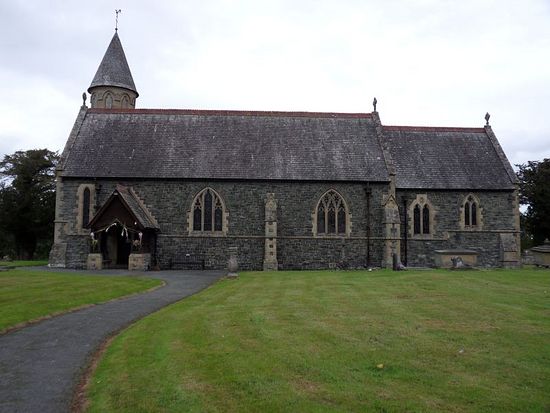 St. Tysilio's Church in Llandysilio, Powys (photo by John Scott from 'British Listed Buildings' website)
St. Tysilio's Church in Llandysilio, Powys (photo by John Scott from 'British Listed Buildings' website)
At least four settlements in modern Wales bear the name of our saint: these are the villages of Llantysilio (alternatively: Llandysilio-yn-Ial) in Denbighshire, Llandysilio in Powys, and Llandissilio (also Llandissilio West) in Pembrokeshire, along with the community of Llandysiliogogo in Ceredigion. Each of these villages (except for the community at the end of the list) has a parish church dedicated to St. Tysilio. The church in the Denbighshire’s village, on the River Dee near the town of Llangollen, was founded by the saint, then rebuilt in the fifteenth century, and the present structure dates back to the Victorian era when it was refurbished by Charles Beyer (1813-1876), a talented German-British builder. The church in the Powys village is situated in an isolated position. It was first built by the saint himself in the seventh century, but the current structure is the 1867 reconstruction. A sixth-century stone with a Latin inscription “Carantacus” is set into the floor of its nave. In the Pembrokeshire village the church is medieval in origin, although its nave was renewed by 1840. Its oldest features are three fifth or sixth-century inscribed stones (parts of crosses) set into the nave walls.
Another historic church in honor of Tysilio can be found in the village of Brynelgwys(meaning “Church Hill”) in Denbighshire. The original church was erected in the seventh century by its patron Tysilio, whereas the existing structure is of the fifteenth century with some Elizabethan and later additions. It is flanked by yew-trees. The village extends up the hills, whose collective name is “Llantysilio Mountain”. Other dedications to St. Tysilio are scattered through Powys, in the former districts of Clwyd and Cardiganshire and also on the borders of the counties Pembrokeshire and Carmarthenshire.
It is noteworthy that the name of St. Tysilio is present in the longest place name in Britain (and presumably one of the longest in Europe and the world). It is located on Anglesey and called «Llanfairpwllgwyngyllgogerychwyrndrobwllllantysiliogogogoch» (fifty-eight letters). Its name means in English “St. Mary’s Parish Church in the Hollow of the White Hazeltree (Township) Near the Rapid Whirlpool and St. Tysilio’s Parish Church with the Red Cave”. This large village sits on the Menai Straits beside the Britannia Bridge on Anglesey. True, it has only a church of the Virgin Mary, though its connection with the saint is vague. It derived its extremely long name in the nineteenth century and the made-up name were meant to attract more tourists, which it has done.
In our days Christians in both Wales and Brittany still venerate St. Tysilio and he is remembered in parish churches, sculptures and other monuments in these regions. Apart from St. Suliac in Brittany, mentioned above, let us also mention the Breton village of Sizun in the Finistere department. It has a very splendid St. Suliau (that is, St. Tysilio) parish church along with an ossuary (bone house) chapel, a triumphal arch and a prominent statue of the Virgin Mary with the Christ Child. Both the church and the chapel are beautifully adorned and you can find many figures of saints outside and inside alike, including several statues of St. Tysilio. A remarkable relic inside the church is the silver “reliquary bust” of St. Tysilio—a common feature in French churches. The building itself is of the sixteenth—seventeenth centuries.
Holy Father Tysilio of Wales and Brittany, pray to God for us!

